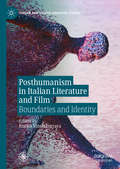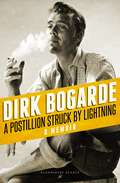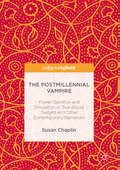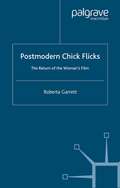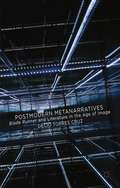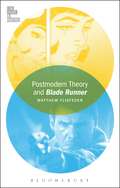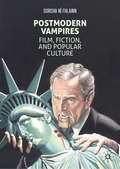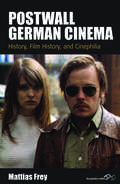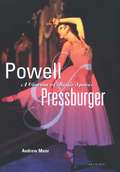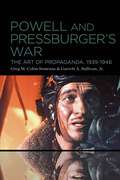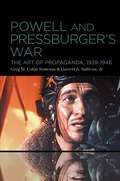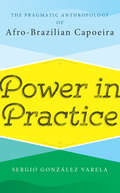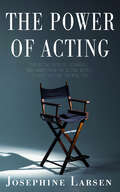- Table View
- List View
Posthumanism in Italian Literature and Film: Boundaries and Identity (Italian and Italian American Studies)
by Enrica Maria FerraraAs humans re-negotiate their boundaries with the nonhuman world of animals,inanimate entities and technological artefacts, new identities are formed and anew epistemological and ethical approach to reality is needed. Through twelvethought-provoking, scholarly essays, this volume analyzes works by a range ofmodern and contemporary Italian authors, from Giacomo Leopardi to ElenaFerrante, who have captured the shift from anthropocentrism and postmodernismto posthumanism. Indeed, this is the first academic volume investigating narrativeconfigurations of posthuman identity in Italian literature and film.
A Postillion Struck by Lightning: A Memoir
by Dirk BogardeFirst published in 1977, A Postillion Struck by Lightning is volume one of Dirk Bogarde's best-selling memoirsFollowing Bogarde from childhood through adolescence, to the beginnings of his budding career, A Postillion Struck by Lightning is a heartfelt memoir, offering insight into what created the drive and charisma that eventually made him a star. Dreamy, sun-soaked summers full of freedom spent with his younger sister are mixed with holidays in France and rambling the countryside.Writing plays instead of playing sports, Dirk's talents lay in the creativity of painting and expression rather than in the precision of maths or science, much to the growing concern of his parents. Packed off to live with relatives in Scotland, his father hoped that a proper Scottish education would equip his son to follow in his footsteps for a career in Newspapers.In Scotland, Dirk learned to defend himself, to sound like a native Glaswegian, and to hide his intense homesickness. In essence; he learned to act.
The Postmillennial Vampire: Power, Sacrifice and Simulation in True Blood, Twilight and Other Contemporary Narratives
by Susan ChaplinThis book explores the idea that while we see the vampire as a hero of romance, or as a member of an oppressed minority struggling to fit in and acquire legal recognition, the vampire has in many ways changed beyond recognition over recent decades due to radically shifting formations of the sacred in contemporary culture. The figure of the vampire has captured the popular imagination to an unprecedented extent since the turn of the millennium. The philosopher René Girard associates the sacred with a communal violence that sacred ritual controls and contains. As traditional formations of the sacred fragment, the vampire comes to embody and enact this ‘sacred violence’ through complex blood bonds that relate the vampire to the human in wholly new ways in the new millennium.
The Postmillennial Vampire: Power, Sacrifice and Simulation in True Blood, Twilight and Other Contemporary Narratives
by Susan ChaplinThis book explores the idea that while we see the vampire as a hero of romance, or as a member of an oppressed minority struggling to fit in and acquire legal recognition, the vampire has in many ways changed beyond recognition over recent decades due to radically shifting formations of the sacred in contemporary culture. The figure of the vampire has captured the popular imagination to an unprecedented extent since the turn of the millennium. The philosopher René Girard associates the sacred with a communal violence that sacred ritual controls and contains. As traditional formations of the sacred fragment, the vampire comes to embody and enact this ‘sacred violence’ through complex blood bonds that relate the vampire to the human in wholly new ways in the new millennium.
Postmodern Chick Flicks: The Return of the Woman's Film
by R. GarrettIn this extensive analysis of the renewed popularity of the 'woman's film' in the 1990s, Roberta Garrett examines melodrama, romantic comedy, costume drama and female-led noirs , revealing the way they blend classical and contemporary themes and formal devices.
Postmodern Metanarratives: Blade Runner and Literature in the Age of Image
by Décio Torres CruzPostmodern Metanarratives investigates the relationship between cinema and literature by analyzing the film Blade Runner as a postmodern work that constitutes a landmark of cyberpunk narrative and establishes a link between tradition and the (post)modern.
Postmodern Theory and Blade Runner (Film Theory in Practice)
by Matthew FlisfederMatthew Flisfeder introduces readers to key concepts in postmodern theory and demonstrates how it can be used for a critical interpretation and analysis of Blade Runner, arguably 'the greatest science fiction film'. By contextualizing the film within the culture of late 20th and early 21st-century capitalism, Flisfeder provides a valuable guide for both students and scholars interested in learning more about one of the most significant, influential, and controversial concepts in film and cultural studies of the past 40 years.The "Film Theory in Practice" series fills a gaping hole in the world of film theory. By marrying the explanation of film theory with interpretation of a film, the volumes provide discrete examples of how film theory can serve as the basis for textual analysis. Postmodern Theory and Blade Runner offers a concise introduction to Postmodernism in jargon-free language and shows how this theory can be deployed to interpret Ridley Scott's cult film Blade Runner.
Postmodern Theory and Blade Runner (Film Theory in Practice)
by Matthew FlisfederMatthew Flisfeder introduces readers to key concepts in postmodern theory and demonstrates how it can be used for a critical interpretation and analysis of Blade Runner, arguably 'the greatest science fiction film'. By contextualizing the film within the culture of late 20th and early 21st-century capitalism, Flisfeder provides a valuable guide for both students and scholars interested in learning more about one of the most significant, influential, and controversial concepts in film and cultural studies of the past 40 years.The "Film Theory in Practice" series fills a gaping hole in the world of film theory. By marrying the explanation of film theory with interpretation of a film, the volumes provide discrete examples of how film theory can serve as the basis for textual analysis. Postmodern Theory and Blade Runner offers a concise introduction to Postmodernism in jargon-free language and shows how this theory can be deployed to interpret Ridley Scott's cult film Blade Runner.
Postmodern Vampires: Film, Fiction, and Popular Culture
by Sorcha Ní FhlainnPostmodern Vampires: Film, Fiction, and Popular Culture is the first major study to focus on American cultural history from the vampire’s point of view. Beginning in 1968, Ní Fhlainn argues that vampires move from the margins to the centre of popular culture as representatives of the anxieties and aspirations of their age. Mapping their literary and screen evolution on to the American Presidency, from Richard Nixon to Donald Trump, this essential critical study chronicles the vampire’s blood-ties to distinct socio-political movements and cultural decades in the late twentieth and early twenty-first centuries. Through case studies of key texts, including Interview with the Vampire, The Lost Boys, Blade, Twilight, Let Me In, True Blood and numerous adaptations of Dracula, this book reveals how vampires continue to be exemplary barometers of political and historical change in the American imagination. It is essential reading for scholars and students in Gothic and Horror Studies, Film Studies, and American Studies, and for anyone interested in the articulate undead.
Postmortems from Game Developer: Insights from the Developers of Unreal Tournament, Black & White, Age of Empire, and Other Top-Selling Games
by Austin GrossmanThe popular Postmortem column in Game Developer magazine features firsthand accounts of how some of the most important and successful games of recent years have been made. This book offers the opportunity to harvest this expertise with one volume. The editor has organized the articles by theme and added previously unpublished analysis to reveal successful management techniques. Readers learn how superstars of the game industry like Peter Molyneux and Warren Spector have dealt with the development challenges such as managing complexity, software and game design issues, schedule challenges, and changing staff needs.
Postmortems from Game Developer: Insights from the Developers of Unreal Tournament, Black & White, Age of Empire, and Other Top-Selling Games
by Austin GrossmanThe popular Postmortem column in Game Developer magazine features firsthand accounts of how some of the most important and successful games of recent years have been made. This book offers the opportunity to harvest this expertise with one volume. The editor has organized the articles by theme and added previously unpublished analysis to reveal successful management techniques. Readers learn how superstars of the game industry like Peter Molyneux and Warren Spector have dealt with the development challenges such as managing complexity, software and game design issues, schedule challenges, and changing staff needs.
Postwall German Cinema: History, Film History and Cinephilia (Film Europa #14)
by Mattias FreySince the fall of the Berlin Wall, there has been a proliferation of German historical films. These productions have earned prestigious awards and succeeded at box offices both at home and abroad, where they count among the most popular German films of all time. Recently, however, the country’s cinematic take on history has seen a significant new development: the radical style, content, and politics of the New German Cinema. With in-depth analyses of the major trends and films, this book represents a comprehensive assessment of the historical film in today’s Germany. Challenging previous paradigms, it takes account of a postwall cinema that complexly engages with various historiographical forms and, above all, with film history itself.
Pound and Pasolini: Poetics of Crisis (Palgrave Studies in Modern European Literature)
by Sean MarkIn October 1967, Pier Paolo Pasolini travelled to Venice to interview Ezra Pound for broadcast on national television. One a lifelong Marxist, the other a former propagandist for the Fascist regime, their encounter was billed as a clash of opposites. But what do these poets share? And what can they tell us about the poetics and politics of the twentieth century? This book reads one by way of the other, aligning their engagement with different temporalities and traditions, polities and geographies, languages and forms, evoked as utopian alternatives to the cultural and political crises of capitalist modernity. Part literary history, part comparative study, it offers a new and provocative perspective on these poets and the critical debates around them – in particular, on Pound’s Italian years and Pasolini’s use of Pound in his work. Their connection helps to understand the implications and legacies of their work today.
Powell and Pressburger: A Cinema of Magic Spaces (Cinema and Society)
by Andrew MoorThe film-making partnership of Michael Powell and Emeric Pressburger was one of the most remarkable and visionary in cinema. They made an extraordinary range of films, from The Spy in Black and The Life and Death of Colonel Blimp to A Canterbury Tale and The Red Shoes. With champions like Martin Scorsese and Francis Ford Coppola, and revived critical interest worldwide, they now find new generations of admirers. This illuminating new book looks closely at these classic films to explore their complex relationship to national identity, and their interest in exile, borderlands, utopias, escapism, art and fantasy. Moor reveals for example how the visual imagery of the films of the Second World War question current cinematic styles and how post war films like The Red Shoes and The Tales of Hoffman are in their highly expressive use of design, music and dance utterly international in character.
Powell and Pressburger’s War: The Art of Propaganda, 1939-1946
by Professor Greg M. Semenza Garrett A. Sullivan Jr.A focused study on Michael Powell and Emeric Pressburger's cinematic contributions to the war effort, arguing for the centrality of propaganda to their work as film artists.Michael Powell and Emeric Pressburger are widely hailed as two of the greatest filmmakers in British cinema history. The release of their first movie, The Spy in Black, barely preceded the beginning of World War Two, and a number of their early masterworks, including The Life and Death of Colonel Blimp, A Canterbury Tale, and A Matter of Life and Death, were produced in the service of the war effort. Through exploring the relationship between art and propaganda, this book shows that Powell and Pressburger saw no contradiction between their aesthetic ambitions and their cinematic war work: propaganda imperatives were highly conducive to their objectives as both commercial cinema practitioners and artists.Drawing on production materials from the archives of the British Film Institute, this book charts three phases in Powell and Pressburger's wartime career: from first-time collaborators who strive to reconcile popular cinematic forms with developing notions of what constitutes effective propaganda; to accomplished, and sometimes controversial, propagandists whose movies center upon Britain's relations with its enemies and allies; to filmmakers whose responsiveness to the propaganda requirements of the late war is matched by a focus, shared by the Ministry of Information, on what the post-war future would bring.
Powell and Pressburger’s War: The Art of Propaganda, 1939-1946
by Professor Greg M. Semenza Garrett A. Sullivan Jr.A focused study on Michael Powell and Emeric Pressburger's cinematic contributions to the war effort, arguing for the centrality of propaganda to their work as film artists.Michael Powell and Emeric Pressburger are widely hailed as two of the greatest filmmakers in British cinema history. The release of their first movie, The Spy in Black, barely preceded the beginning of World War Two, and a number of their early masterworks, including The Life and Death of Colonel Blimp, A Canterbury Tale, and A Matter of Life and Death, were produced in the service of the war effort. Through exploring the relationship between art and propaganda, this book shows that Powell and Pressburger saw no contradiction between their aesthetic ambitions and their cinematic war work: propaganda imperatives were highly conducive to their objectives as both commercial cinema practitioners and artists.Drawing on production materials from the archives of the British Film Institute, this book charts three phases in Powell and Pressburger's wartime career: from first-time collaborators who strive to reconcile popular cinematic forms with developing notions of what constitutes effective propaganda; to accomplished, and sometimes controversial, propagandists whose movies center upon Britain's relations with its enemies and allies; to filmmakers whose responsiveness to the propaganda requirements of the late war is matched by a focus, shared by the Ministry of Information, on what the post-war future would bring.
Power in Practice: The Pragmatic Anthropology of Afro-Brazilian Capoeira
by Sergio González VarelaConsidering the concept of power in capoeira, an Afro-Brazilian ritual art form, Varela describes ethnographically the importance that capoeira leaders (mestres) have in the social configuration of a style called Angola in Bahia, Brazil. He analyzes how individual power is essential for an understanding of the modern history of capoeira, and for the themes of embodiment, play, cosmology, and ritual action. The book also emphasizes the great significance that creativity and aesthetic expression have for capoeira’s practice and performance.
The Power of Acting
by Josephine LarsenACTING is a vast and relatively unknown subject... for many. And yet millions are fascinated by it. Why? The answer is because this all-encompassing human art form is as fundamental to the self-actualisation of a human being as reading, writing and maths. We sense this. We know it. Surely the possession of such knowledge would be of great advantage in any profession, in any walk of life, and not just the preserve of stage and film? Why are we not taught these playful and transformative skills in school? This book uncovers why, and reveals top acting secrets, techniques and games that will dramatically change the way you see yourself and the world around you. 'This is a wonderfully helpful book regarding the importance of adults learning to play again, in order to free themselves from the oppressive everyday tramlines we follow... Josephine is a great inspiration to many people and this book will show you why.' Peter Richardson - founder of the COMIC STRIP troupe 'Sculptress of the creative spirit, enkindling in even our most timid selves a passion for play, interconnectedness, listening, ritual and generosity on all of life's stages,Josephine is an indelible force of love and wisdom, at once ready for a fit of laughter or all hell to break loose. For her teachings and humanity, my immeasurable gratitude! Watch out for that fourth wall; you might fall through it reading this book.' Seumas F. Sargent, Performer, Blue Man Group, Berlin 'You're a rock, an inspiration, a star-I wish to the heavens I'd had teachers like you when I was at school! My God, I could have done anything.' Richard Down - a player 'My life changed beyond all recognition during the last four years coming to your classes with many, many challenges. The safe loving environment you created has been a great source of strength-even when I have been unable to attend! It has been a very important part of my liberation.' Louise Gough - a player
The Power of Art
by Simon Schama CBE* 'Great art has dreadful manners...' Simon Schama observes at the start of his epic exploration of the power, and whole point, of art. 'The hushed reverence of the gallery can fool you into believing masterpieces are polite things, visions that soothe, charm and beguile, but actually they are thugs. Merciless and wily, the greatest paintings grab you in a headlock, rough up your composure and then proceed in short order to re-arrange your sense of reality...' * With the same disarming force, Power of Art jolts us far from the comfort zone of the hushed art gallery, as Schama closes in on intense make-or-break turning points in the lives of eight great artists who, under extreme stress, created something unprecedented, altering the course of art for ever. * The embattled heroes - Caravaggio, Bernini, Rembrandt, David, Turner, Van Gogh, Picasso and Rothko - faced crisis with steadfast defiance. The masterpieces they created challenged convention, shattered complacency, shifted awareness and changed the way we look at the world. With powerfully vivid story-telling, Schama explores the dynamic personalities of the artists and the spirit of the times they lived through, capturing the flamboyant theatre of bourgeois life in Amsterdam, the passion and paranoia of Revolutionary Paris, and the carnage and pathos of civil-war Spain.* Most compelling of all, Power of Art traces the extraordinary evolution of eight world-class works of art. Created in a bolt of illumination, such works 'tell us something about how the world is, how it is to be inside our skins, that no more prosaic source of wisdom can deliver. And when they do that they answer, irrefutably and majestically, the nagging question of every reluctant art-conscript... "OK, OK, but what's art really for?"'
The Power of Global Community Media
by Linda K. FullerDrawing on both theoretical and practical case studies, this collection moves from developing attempts at local media to case studies and on to cyber-examples. The contributors, all distinguished international communications scholars, present a range of perspectives on the ever-burgeoning area of grassroots, local media.
The Power Of Hope: The moving memoir from TV’s Kate Garraway
by Kate GarrawayKate Garraway shares the raw and emotional story of the devastating impact that Covid-19 has had on her family - and how they are finding strength in hope.In March 2020, Kate Garraway's husband, Derek Draper, contracted Covid-19 and was placed in a medically-induced coma. Initially, Kate was told that he would not survive. A year later he was still in hospital. Now at home but requiring round-the-clock care, he is thought to be the UK's longest-fighting Covid-19 patient.In this intimate book, Kate shares her deeply personal story. As well as recounting how the illness took hold of their lives, she writes about how she is coping with the uncertainty of their future, how she's supporting her children through this traumatic time, how she has found strength in community and how she strives to hold on to hope even at the darkest of times. Covid-19 has affected everyone across the country in so many ways and Kate hopes that by revealing her own personal experience, it will give comfort to others. By sharing the lessons she has learnt along the way, it will help us all begin to try to re-build our lives.Kate's exceptional courage, positivity and warmth shine through on every page, making The Power of Hope a truly inspiring read that will resonate with all of us whose lives continue to be touched by the virus.
The Power of Virtual Reality Cinema for Healthcare Training: A Collaborative Guide for Medical Experts and Media Professionals
by Bob Fine Eric R. Williams John Bowditch Adonis DuradoCinematic Virtual Reality brings a combination of documentary, narrative and game design principles to the medical profession and, in the healthcare arena, collaboration is a key component for creating intellectually- and emotionally- rich immersive experiences. "The Power of Virtual Reality Cinema for Healthcare Training" gathers more than a dozen experts from both the production and healthcare fields to break down best practices for creating successful cine-VR projects. Designed for multi-disciplinary teams interested in integrating cine-VR production into their healthcare training and educational programs, this book has been written for two audiences: the healthcare professional interested in what production experts consider when approaching a project, and the media expert curious about how this new technology can be used in the medical field. Highlights include: Cutting edge medical education techniques developed by Ohio University’s GRID Lab, including: PREality (creating a forced sense of deja-vu to increase acclimation time), a unique approach to eye-tracking to enhance team performance, and the low-CRIS technique (a low-cost rapid implementation strategy to capture patient care for rapid graduate student training). Insightful production techniques that will enhance your cine-VR projects including advanced plating methods to hide lighting set-ups, immersive audio considerations, and new ways to consider 360 storytelling including the Lovrick montage and the Christmas Carol continuum for story development. Detailed explanations of the production considerations and results of specific cine-VR productions (from funding approaches to distribution) including access to more than five hours of cine-VR examples of the actual productions available for download. Details on a wide variety of medical cine-VR projects, including 100 images that illustrate best practices for topics such as recording in active medical facilities, building successful multi-disciplinary teams, working within HIPAA regulations, conceptualizing cine-VR libraries for graduate education, and implementing innovative distribution models.
The Power of Virtual Reality Cinema for Healthcare Training: A Collaborative Guide for Medical Experts and Media Professionals
by Eric R. Williams John BowditchCinematic Virtual Reality brings a combination of documentary, narrative and game design principles to the medical profession and, in the healthcare arena, collaboration is a key component for creating intellectually- and emotionally- rich immersive experiences. "The Power of Virtual Reality Cinema for Healthcare Training" gathers more than a dozen experts from both the production and healthcare fields to break down best practices for creating successful cine-VR projects. Designed for multi-disciplinary teams interested in integrating cine-VR production into their healthcare training and educational programs, this book has been written for two audiences: the healthcare professional interested in what production experts consider when approaching a project, and the media expert curious about how this new technology can be used in the medical field. Highlights include: Cutting edge medical education techniques developed by Ohio University’s GRID Lab, including: PREality (creating a forced sense of deja-vu to increase acclimation time), a unique approach to eye-tracking to enhance team performance, and the low-CRIS technique (a low-cost rapid implementation strategy to capture patient care for rapid graduate student training). Insightful production techniques that will enhance your cine-VR projects including advanced plating methods to hide lighting set-ups, immersive audio considerations, and new ways to consider 360 storytelling including the Lovrick montage and the Christmas Carol continuum for story development. Detailed explanations of the production considerations and results of specific cine-VR productions (from funding approaches to distribution) including access to more than five hours of cine-VR examples of the actual productions available for download. Details on a wide variety of medical cine-VR projects, including 100 images that illustrate best practices for topics such as recording in active medical facilities, building successful multi-disciplinary teams, working within HIPAA regulations, conceptualizing cine-VR libraries for graduate education, and implementing innovative distribution models.
The power of vulnerability: Mobilising affect in feminist, queer and anti-racist media cultures (The\manchester Spenser Mup Ser.)
by Ingrid Ryberg Katariina Kyrölä Anu KoivunenThis book investigates the new language of vulnerability that has emerged in feminist, queer and antiracist debates on media, taking a particular interest in the historical legacies and contemporary forms and effects of this language. Contributors such as Jack Halberstam and Sara Ahmed examine how vulnerability has become a battleground, how affect and vulnerability have turned into a politicised currency both for addressing and obscuring asymmetries of power, and how media activism and state policies address so-called vulnerable groups. Taking on such heated topics as trigger warnings and diversity policies, the book will be of interest to scholars and students in media and cultural studies, affect theory, gender studies, queer theory and critical race studies.
Practical Art of Motion Picture Sound
by David Lewis YewdallPractical Art of Motion Picture Sound, 4th edition relies on the professional experience of the author and other top sound craftspeople to provide a comprehensive explanation of film sound, including mixing, dubbing, workflow, budgeting, and digital audio techniques.
